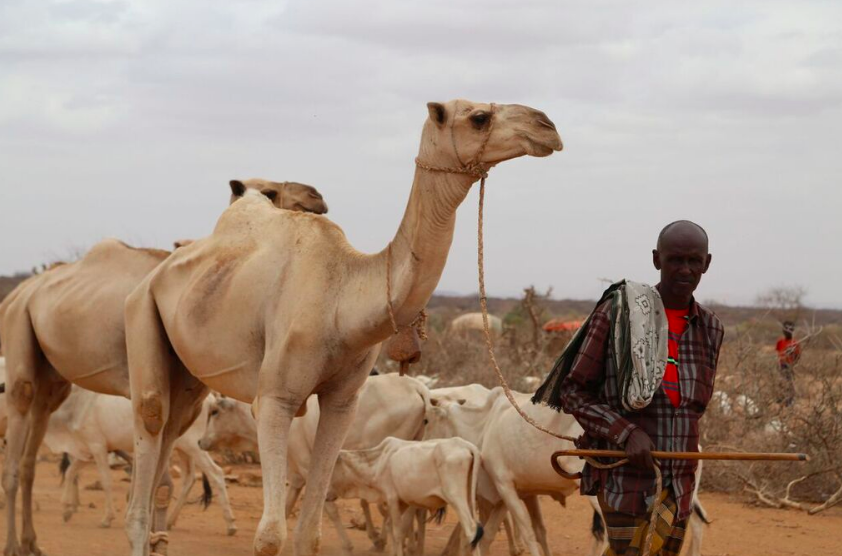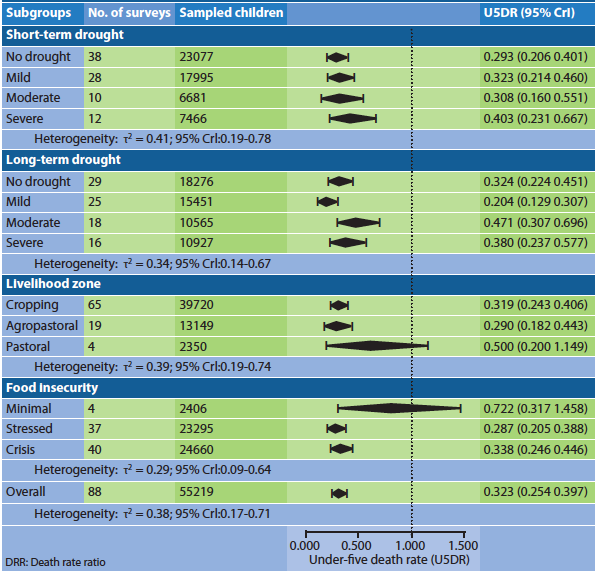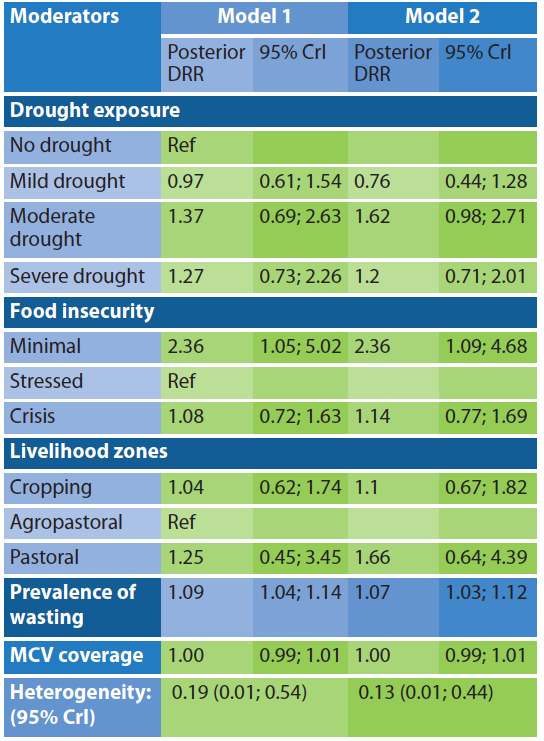Short and long-term droughts, food security and child mortality in Ethiopia: Can sub-national surveys tell us more about the success of mitigation efforts?
Summary of presentation1
By Tefera Darge Delbiso, Chiara Altare, Jose Manuel Rodriguez-Llanes, Shannon Doocy and Debarati Guha-Sapir
Tefera Darge Delbiso is a Research Associate with the Center for Research on the Epidemiology of Disasters (CRED). He has a multidisciplinary background, broad and progressive work experience in research, teaching and consultancy, and an extensive record of publication in reputable journals.
Chiara Altare holds a PhD and an MSc in Public Health from the University of Louvain, Belgium. She has ten years’ experience in research and evaluation in development and humanitarian settings and is currently working as Impact Assessment Advisor for Action Contre la Faim, Paris.
Jose Manuel Rodriguez-Llanes is a disaster and conflict epidemiologist. He obtained his PhD from the CRED, Louvain School of Public Health, Belgium. He is currently a scientific officer at the European Commission Joint Research Centre, where he investigates the measurement and drivers of resilience to food and nutrition security in disaster and conflict settings.
Shannon Doocy is an Associate Professor with the Johns Hopkins Center for Refugee and Disaster Response. She has worked in numerous countries in collaboration with United Nations agencies, governments and non-government organisations, and has published extensively on the impact of natural disasters and conflict on public health in emergencies.
Professor Debarati Guha-Sapir is the Director of the CRED and a Professor at Université catholique de Louvain. She has been involved in field research and training in emergency and humanitarian issues for more than 30 years.
The authors would like to thank all agencies that conducted the surveys and shared their reports with the Complex Emergency Database team, FEWS NET for providing the food security data, and Global Drought Monitor for the drought data. This research was supported by the Association pour l’Epidemiologie de Désastres, Université catholique de Louvain and Fond National de Recherche Scientifique.
Location: Ethiopia
What we know: There is a lack of global and country-specific evidence on the health impacts of climate change, especially drought, and the impact of programmes to mitigate public health and nutrition consequences.
What this article adds: Recurrent droughts now pose an unprecedented threat in Ethiopia; more than 80 per cent of the population is dependent on subsistence and rain-fed agriculture. The effects of drought on child mortality in Ethiopia between 2009 and 2014 were explored using 88 small-scale, complex emergency database (CE-DAT) mortality surveys (55,219 children) and Famine Early Warning Systems Network (FEWS NET) data, coupled with intensity of drought exposure. Most of the surveys were in highly populated regions; 95 per cent were stressed/crisis-level food security. The under-five death rate (U5DR) was lower than emergency threshold and baseline threshold for sub-Saharan Africa. This is consistent with general positive child mortality trends in Ethiopia but may be an underestimate due to inaccessibility of some crisis-affected areas. There was no association between U5DR and both short and long-term droughts. Areas with minimal food insecurity had higher U5DRs than stressed areas; the latter may attract more support. Child mortality was associated with prevalence of wasting that remained high (>10%) in crisis-affected areas. The findings reflect important progress in drought resilience; further targeted interventions are needed.
Background
The health impact of droughts is intuitive, although indirect and complex. Drought has been associated with excess mortality and can cause nutrition and health problems, aggravate chronic diseases, reduce crop and livestock production, contribute to inflation of food prices and trigger drought-induced migration. The severity of its effects depends on socioeconomic conditions, infrastructure development, stability and the general environment, which directly influence the resilience capacity of the population (Stanke et al, 2013).
Drought mitigation efforts have improved enormously over the last few decades; however, in recent times, the frequency of droughts and their impacts have increased in Ethiopia, with incidents now occurring annually in some parts of the country. The majority of the population in Ethiopia is also highly vulnerable, as more than 80 per cent of people are dependent on subsistence and rain-fed agriculture; the 2015-2016 El Niño induced-droughts caused a drop in agricultural yield of up to 80 per cent in some areas. Consequently, recurrent droughts now pose an unprecedented threat in Ethiopia.
Rigorous synthesis of empirical data on the health impacts of climate change in general and droughts in particular are lacking in Ethiopia and elsewhere in the world. This, in turn, creates an evidence vacuum in terms of evaluating the impact of ongoing programmes to reduce the public health impact of droughts and guide effective adaptation strategies. To address this research gap and provide a sound quantitative synthesis, the effects of drought on child mortality in Ethiopia between 2009 and 2014 were explored, considering real-time data on the intensity of drought exposure.
 Methods
Methods
Under-five death, nutrition and vaccination data: A total of 88 sub-national (small-scale) mortality surveys were extracted from the Complex Emergency Database (CE-DAT) (Altare and Guha-Sapir, 2014). The surveys were conducted between January 2009 and December 2014 by humanitarian agencies operating in Ethiopia. Surveys were selected based on the following criteria: 1) conducted in permanent resident populations; 2) used probability sampling methods; 3) based on a three-month recall period; and 4) the under-five death rate (U5DR) and/or sample size was provided or could be estimated. The following indicators were extracted: U5DR; prevalence of child wasting, measles antigen-containing vaccines (MCV) coverage; survey coverage area of the woreda (the third tier of regional administration); and survey month and year.
Drought exposure data: The standardised precipitation evapotranspiration index (SPEI) was used. This is an improved index to identify the spatial and temporal extent of drought exposure and its intensity. The SPEI is calculated for different timescales (for example; one, three, six and 12 months), considering the combined effect of precipitation and temperature. The different timescales are important for assessment of drought effects on child mortality as effects are likely to vary with the frequency and duration of droughts. Thus, in this study, the three-month and 12-month SPEIs were used to identify the short and long-term droughts, respectively. The SPEI data was downloaded from the Global Drought Monitor and categorised into: no drought (SPEI > 0); mild drought (−1 < SPEI ≤ 0); moderate drought (−1.5 < SPEI ≤ −1); and severe-to-extreme drought (severe drought hereafter) (SPEI ≤ −1.5).
Food security and livelihood zones data: Food security and livelihood zones data were obtained from the Famine Early Warning Systems Network (FEWS NET), which provides evidence-based analysis on early warning and food insecurity. FEWS NET uses the Integrated Food Security Phase Classification (IPC), a set of tools and procedures that identify and classify the severity of food insecurity. The IPC classifies areas with food insecurity into five phases: minimal, stressed, crisis, emergency and famine. The drought, food security and livelihood zone data were then matched with a CE-DAT survey of a given area using global positioning system (GPS) coordinates.
Statistical analysis: The datasets were merged across space and time and a random-effects meta-analysis was undertaken to summarise survey results and explore heterogeneity across independently conducted but methodologically similar small-scale surveys. Variability was explored across the survey estimates using the between-survey variance statistic. To explain the variability, meta-analyses were performed on sub-groups based on survey-specific contextual moderators (drought exposure levels, food insecurity and livelihood zones). A meta-regression analysis was subsequently undertaken, adjusting for additional moderators, prevalence of wasting and MCV coverage. A fifth of included surveys had zero counts for U5DR, leading to undefined variance estimates. To circumvent this problem, the Poisson regression model was used for meta-analysis in a Bayesian framework.
Results and discussion
Overall, 55,219 children under five years old were covered in the 88 surveys included in the meta-analysis. The surveys covered seven of the 11 administrative regions in Ethiopia. Most of the surveys were from the three highly populated regions of the country: Oromia (38, 43.2%); Amhara (22, 25.0%); and the Southern Nations, Nationalities and People (18, 20.5%). More than half the surveys (50, 56.8% and 59, 67.0%) were conducted in areas affected by mild-to-severe drought in the short and long-term, respectively. The overwhelming majority of the surveys (84, 95%) were conducted in areas suffering from stressed or crisis-level food insecurity. Sixty-five (73.8%) were conducted in cropping areas (See Figure 1).
Figure 1: Pooled U5DR and 95% credible intervals, stratified by short and long-term drought exposure, food insecurity and livelihood zones from 88 small-scale mortality surveys from Ethiopia, 2009-2014.

Results of the pooled analysis showed that the U5DR during the study period of 0.323/10,000/day (95% credible interval (CrI): 0.254-0.397) (see Figure 1) is lower than both the emergency threshold death rate of 2.1/10,000/day and the baseline threshold of 1.07 for sub-Saharan Africa. This result is consistent with the fact that Ethiopia, in general, has shown great improvement in reducing child mortality and successfully achieved the millennium development goal (MDG) three years ahead of the 2015 deadline. The result may also reflect the positive contribution of humanitarian agencies in supporting national programmes to improve health, thereby reducing mortality. However, possible underestimation of mortality due to inaccessibility of some of the crises-affected areas and exclusion of non-permanent residents (such as refugees) should not be ruled out. Emergency thresholds may also need to be reviewed as current thresholds date back to 1997, when the Sphere project (Humanitarian Charter and Minimum Standard in Disaster Response) was launched.
Results from the sub-group meta-analysis and meta-regression show no association between U5DR and both short and long-term droughts during the study period (See Table 1). This can be partially explained by the resilience capacity Ethiopia has developed to deal with droughts and food shortages. This has involved the strengthening in recent years of weather forecasting and early warning systems; increased timeliness and predictability of relief assistance; rollout of the national productive safety net programme (PSNP), which minimises vulnerability to food insecurity among chronically food-insecure households in famine-prone areas; and road network development over the last decade, which has helped farmers to access markets and helped relief providers to access remote villages.
Results also show that areas with minimal food insecurity had higher U5DRs than areas reporting stressed food insecurity (See Table 1). It may be that these areas do not attract the support of government and aid agencies and therefore do not receive the assistance that contributes to the improvement of child survival, such as healthcare, food assistance and other relief commodities.
Results also confirmed the well-documented finding that child mortality increases with increased prevalence of wasting (See Table 1). Despite the declining trend, the prevalence of wasting in crisis-affected areas in Ethiopia remains high, at more than 10% (Delbiso et al, 2017). Targeted interventions are therefore needed to improve child nutrition, thereby boosting child survival.
Table 1: Results from Bayesian Poisson meta-regression models of small-scale mortality surveys from Ethiopia, 2009-2014.

DRR: Death rate ratio
Model 1 investigates the effect of short-term droughts on child mortality. Model 2 investigates the effect of long-term droughts on child mortality; both are adjusted for survey-specific moderators (food insecurity, livelihood zones, prevalence of wasting and MCV coverage).
Conclusions
The estimated pooled U5DR was below both the emergency and the baseline threshold for sub-Saharan Africa. This reflects the huge progress that has been made in reducing child mortality in Ethiopia, but may also indicate important sub-populations not represented in the data (non-permanent residents, inaccessible crisis areas) and the need to review and update existing emergency mortality thresholds. The study also found that, within the surveyed population, both short and long-term drought exposures were not associated with U5DR; however, minimal food insecurity was associated with elevated U5DR. This is consistent with earlier findings that moderate drought-affected areas presented elevated wasting prevalence (Delbiso et al, 2017) and indicates that these areas should not be overlooked by intervention programmes, particularly the Ethiopia PSNP. The results of this study reflect the enormous progress made in Ethiopia in developing drought resilience and show that further targeted interventions are crucial to reduce the prevalence of acute malnutrition in order to further reduce the U5DR.
For more information, contact Tefera Darge Delbiso.
Endnotes
1Presentation at the ACF Research for Nutrition Conference, Pavillon de L’Eau, 13th November, 2017.
References
Altare C and Guha-Sapir D. The Complex Emergency Database: A Global Repository of Small-Scale Surveys on Nutrition, Health and Mortality. PLoS One, vol. 9, no. 10, p. e109022, 2014.
Delbiso TD, Rodriguez-Llanes JM, Donneau A-F, Speybroeck N and Guha-Sapir D. Drought, conflict and children’s undernutrition in Ethiopia 2000–2013: a meta-analysis. Bull World Heal. Organ, vol. 95, pp. 94–102, 2017.
Stanke C, Kerac M, Prudhomme C, Medlock J and Murray V. Health Effects of Drought: a Systematic Review of the Evidence. PLoS Currents Disasters, pp. 1–38, 2013.

